Ultraviolet (UV) water treatment systems effectively inactivate microorganisms*, resulting in lowering the risk of contracting illnesses. The ultraviolet light breaks down and inactivates water borne pathogens, leaving them unable to reproduce. There are several benefits of UV water treatment, here are some examples:
- Cost-effective
- No change to the taste or odor of the water
- Simple maintenance
- No disinfection by-products
- Reduce plastic bottle usage
- Environmentally friendly
- No moving parts to wear out
- Compact systems to fit in small and large places
- No added chemicals
Disinfection is defined as “the act of disinfecting, using specialized cleansing techniques that destroy or prevent growth of organisms capable of infection.”
In regards to water, there are typically two methods of water disinfection:
• Chemical disinfection: chlorine, ozone, iodine, bromine.
• Physical disinfection: UV light, boiling, fine filtration.
In chemical water disinfection a chemical must be added in order to destroy the microorganisms present. One of the most popular methods of chemical disinfection is chlorination, a common disinfection method for drinking water.
Physical disinfection, including boiling, filtration and ultraviolet disinfection, does not require anything to be added to the water. One of the simplest and most effective ways to disinfect drinking water is by using UV disinfection.
|
|
|
|
Using any of the above physical methods will not change the taste, odour or chemical makeup of the water.
*LUMINOR’s systems are tested for reduction of the MS-2 coliphage challenge microorganism to demonstrate a log reduction greater than or equal to the reduction caused by a dose of 40mJ/cm^2*
UV water treatment is a relatively simple process.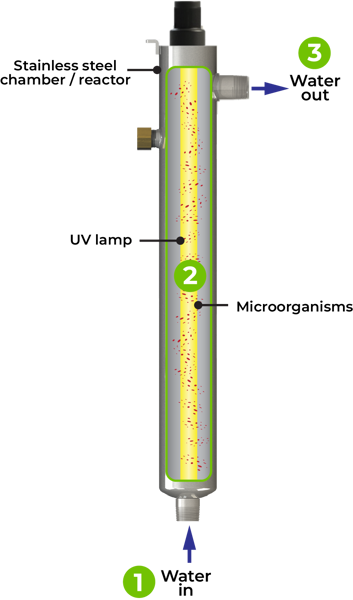
Step 1: Pre-treated water enters the stainless steel chamber flowing around the UV lamp.
Step 2: The microbes in the water are exposed to the ultraviolet light (254nm wavelength) which alters their DNA, making them unable to replicate. The microbes are now harmless.
Step 3: The treated water then leaves the chamber and enters your homes water supply. The water is now safe for drinking, bathing and safe for use in food production.
There are several barriers that can affect UV performance.
- Suspended solids, both visible and non-visible, particulate matter, commonly referred to as turbidity.
- Scaling caused by physical scale deposits on the quartz sleeve from iron, manganese or calcium carbonate.
- UV absorbing compounds, most often caused by dissolved substances. Certain organic substances such as humic or fumic acids (tannins), and certain in-organic substances such as iron and manganese absorb UV light, reducing the chambers effectiveness. These contaminants must be addressed before entering the chamber for UV treatment to be effective. UV is not a stand-alone water treatment process and is always accompanied by other treatment processes.
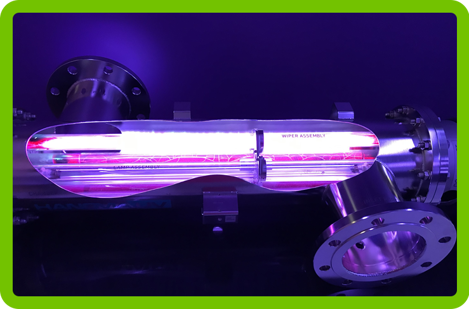
Cutaway model of a UV disinfection reactor
(Credit: Z22 - Own work, CC BY-SA 4.0)
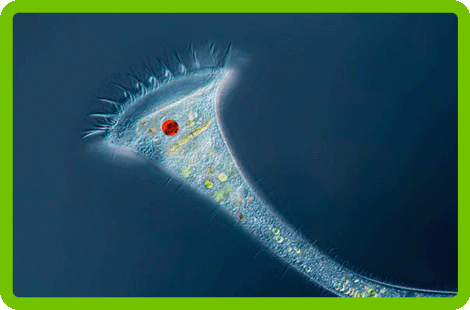
Example of a single-celled protozoa microorganism
Once a UV water treatment system is chosen for the home, the question arises as to where to install the system.
If you only consume the water from one tap, the installation of a point-of-use (POU) UV system may be the best choice if only one tap exists in the dwelling.
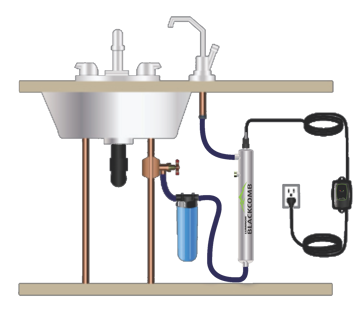
A typical point-of-use installation
For homes that have more than one tap, including a bathroom faucet, the installation of a point-of-entry (POE) UV system will be the best choice for a whole-home water purification system. These systems ensure all water in the building is being treated.
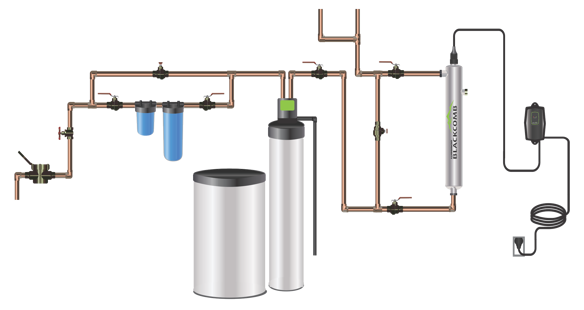
A typical point-of-use installation
 Skip to main content
Skip to main content